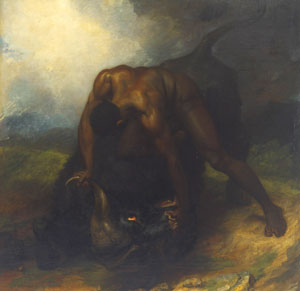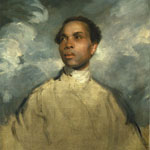David McGee opens Deep Wells and Reflecting Pools, his exhibition of 27 artworks and artifacts selected from the Menil Collection’s large holdings of works of art depicting black identity, with the large painting A Negro Overpowering A Buffalo—A Fact Which Occurred in America.

Marcel Antoine Verdier (French; 1817-1856)...Châtiments des quatre piquets dans les colonies (Beating at Four Stakes in the Colonies)...1849...Oil on canvas; 59 1/4 x 84 1/2 inches
English artist George Dawe illustrated this event in 1809 or 1810 by placing his two protagonists in strongly diagonal poses, a style that revives the heroic struggles of gods and monsters painted several centuries earlier by Baroque master José de Ribera. But while exquisitely buff in physique, Dawe’s naked black man is impervious to identity. Just as type (“Negro”) is the only attribute accorded him in the title, his physical depiction conveys no identity — the human combatant’s face is turned inward, away from the viewer, even as the strongly animated buffalo’s looks outward.
The parallel construction of McGee’s title suggests a world that can be understood only through juxtapository oppositions and polarities. The doppelganger to Dawe’s anonymous hero is also titled to suggest the artist as reporter of an actual event. French painter Marcel Antonin Verdier created Beating at Four Stakes in the Colonies in 1849, when the slavery issue was beginning to boil in the United States. His laconic style is the antithesis of Dawe’s charged romanticism: a naked black man is recorded in full, staked-out as he receives his beating, while both whites and blacks look on to magnify the solitary horror of his predicament.
McGee brings two attributes to his curatorial project, and he is passionate about both his blackness (what he alludes to as his “tribal” identity in an interview with Menil Collection Chief Curator Matthew Drutt) and his artistry (this exhibit is a component of Double Consciousness: Black Conceptual Art Since 1970, now at Houston’s Contemporary Arts Museum, which also features a selection of recent McGee paintings). Deep Wells continues the dichotomies introduced in painting by triangulating the French sculptor Jean-Baptiste Carpeaux’s terracotta bust Why to Be Born a Slave? (1873) with American expatriate Jacob Epstein’s bronze Head of Paul Robeson (1927) and an anonymous American work from the 1800’s, Head of a Black With Rope Burns (Nat Turner). Here McGee is riffing more broadly, across centuries and between high and low, and the value of having an artist interact with a museum collection becomes clear. While separated by 50 years, the romantic naturalism of Carpeaux and the assertive character study of Epstein coexist easily within the context of high art. Sculpted in plaster and tinted with colored beeswax, the anonymous Head of a Black With Rope Burns is only broadly dated, and was probably made toward the end of the 19th century, after the failure of post-Civil War Reconstruction. But while clearly crafted, both its questionable provenance and use contaminate and implicate the nobility of its high art brethren. The tense resonance between these three objects forms the fulcrum of McGee’s exhibition.
This approach carries through to the smaller portrait and ethnographic sketches that are the major component of McGee’s image declension. The even-handed naturalism of Sir Joshua Reynolds’ A Young Black (c. 1770) shares the wall with François-Andre Vincent’s lively ink-on-paper caricature, Portrait of Toussaint-Louverture (1800s). Two studies for Femme de Race Bôchísmamme, by Lasteyrie du Saillant (1759-1849), depict African exoticism with the same fervent, exaggerated “realism” that other contemporary illustrators accorded to newly discovered natural specimens and oddities from foreign lands. On another wall, an anonymous American engraving of Jim Crow from the 1820s vividly if coarsely exemplifies what the African-American literary critic Sterling A. Brown described as the “Local Color Negro” in his 1933 essay Negro Character as Seen by White Authors.

Sir Joshua Reynolds (English; 1723-1792)...A Young Black... ca. 1770...Oil on canvas; 21 x 25 1/8 inches
You might notice from my description how few of the artists are American. This is consistent with both the Menil Collection’s archive and American art history. John Singleton Copley did portray a dignified young man in his Revolutionary War-era Watson and the Shark, but this remained a rarity in his production. Outside of genre painters like William Sydney Mount, William Deas, or Edward Troye, who used black subjects to quite literally establish a scene’s “local color,” very few pre-Civil War artists dared to portray black men or women, let alone portray them like they depicted whites; African-American artists were a rarity. Whether European or American in origin, most of the work in this exhibition was made in the decades before and after the Civil War — one notable exception is David Mossey’s 1969 lithograph Angela Davis, which paraphrases racial identity in political terms.
The slave shackles and bill of sale that McGee includes in the show are now historical artifacts, just as they where once implements of commerce. The exhibit’s other utilitarian or pleasure objects — England’s 19th century The Darkie Game, a 5th century B.C. Greek terracotta Oinochoe (wine jug) in the form of a black head, an English Meerschaum pipe in the shape of a black, or an early 20th century Japanese ashtray whose receptacle is the open mouth of crying black baby — are more problematic. As artifacts they range in aesthetic quality from sublime to banal, but they consistently show vitrolity and open stereotyping as a depressing by-product of mass-production’s supplanting of artistic production.

George Dawe (English; 1781-1829) ... A Negro Overpowering a Buffalo -a fact which occurred in America in 1809... 1810; Oil on canvas; 80 1/4 x 80 1/2 inches
The idea of authorship as ownership echoes throughout this show like a ricochet, and while the intended use of the commercial objects is clear, almost all of the high art images in this show beg the question: Who where these images and objects intended for? What homeowner (American plantation owner? French abolitionist? Neutral third party sadomasochist?) would gratefully commission Beating at 4 Stakes for their dining or sitting room? Into the foyer of what mansion or secret society would Head of a Black With Rope Burns be pedestalled? The lack of naming that permeates this show is one of the most demeaning attributes of racially themed depictions, and is one of the show’s major subthemes. In McGee’s hands the question of naming becomes integral to the question of image ownership, regardless of the image’s provenance as high or low, because naming is how artists position the who, what, and why of subject matter to determine our perception of character. There are many polarities coursing through this show, each a meditation on a theme that I think James Baldwin summed up well in his essay The Devil Finds Work: “To encounter oneself is to encounter the other, and this is love. If I know that my soul trembles, I know that yours does, too: and, if I can respect this, both of us can live.”
Deep Wells and Reflecting Pools was organized by artist David McGee as a site-specific component of the Contemporary Arts Museum Houston’s Double Consciousness: Black Conceptual Art Since 1970. It remains on view at the Menil Collection through April 17.
Images courtesy The Menil Collection.
Christopher French is a writer and artist living in Houston.



